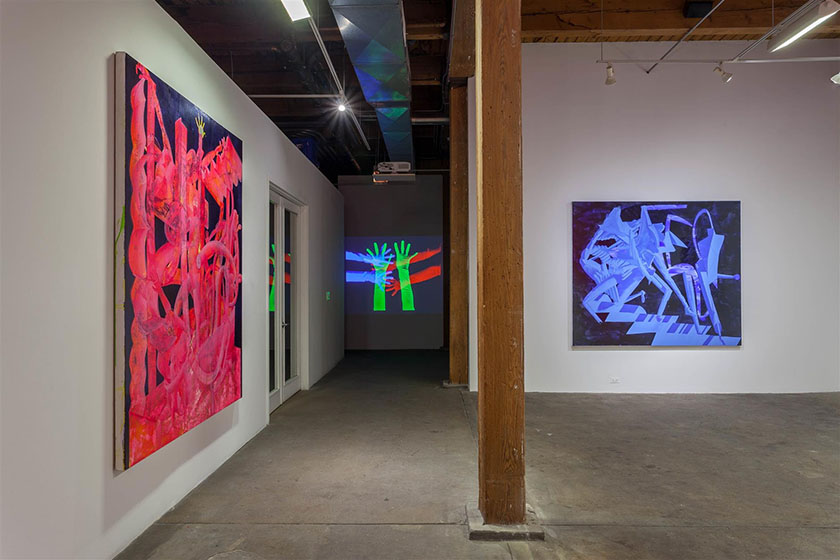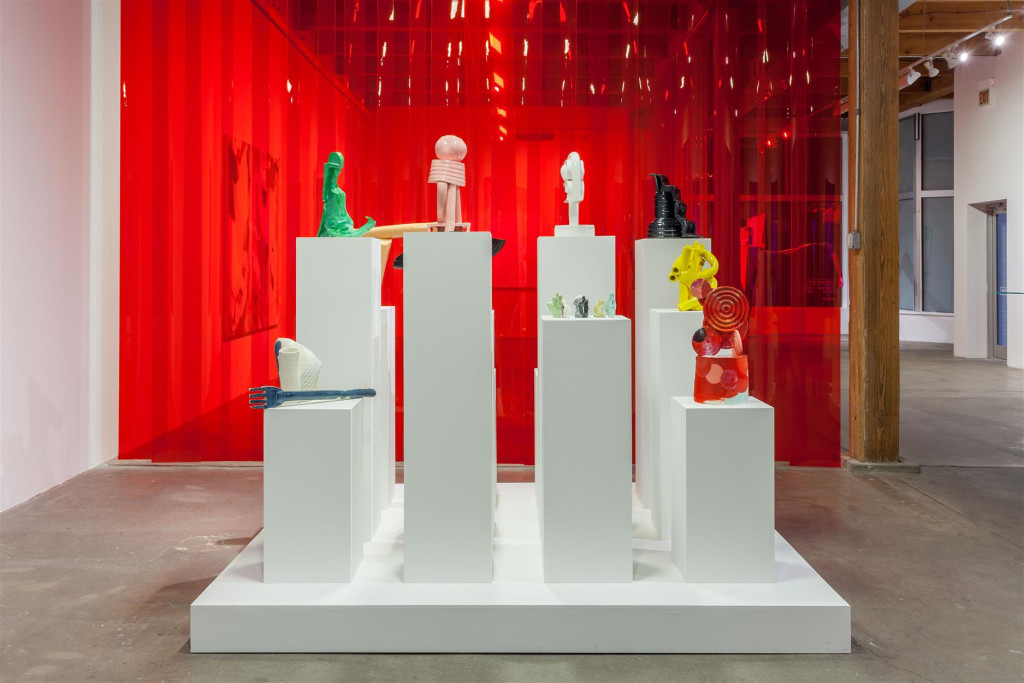Andrew Holmquist: Carrie Secrist
by Caroline Picard
Chicago-based painter Andrew Holmquist thinks and works through multiple mediums to reflect—not only on the act of painting and its central position in his practice, but also the (primarily male) body moving through space. His latest exhibition, Stage Left, includes 26 new works ranging from paintings on canvas, ceramic collaborations, a collaborative fashion sculpture, a collaborative film, and two red-tinted freezer partitions that divide the gallery into three parts. While remaining fully in the realm of abstraction, each work points to one or several human figures, always in motion and never quite coherent.
Select paintings take on Futurist gestures—from a distance the painting Grand Entrance looks like an entirely abstract composition of blocked blue brush stokes on a glossy black background; upon closer inspection however, fragmented body parts draw into focus—a small shoe or a hand—in such a way that the entire assemblage becomes figurative, marching down a series of steps like a character from Fantasia. Sometimes Holmquist’s bodies emerge more clearly in Hockney-esque landscapes. Swim Meet’s (2015) super neon yellow, teal, and hot pink colors describe figures diving in, bending over, standing, or perhaps pulling themselves out of water. Like the bodies, the landscape—its irregular tile, pendant flags, or the diving board captured three times in different stages of motion—slip joyously in and out of representational space.

While the hand of the artist might be explicitly absent from other works in the show, it leaves a trace—the streak of the swimmer’s back elongated by the force of its fall, for instance, or the various depressions of cast ceramics. In back of the gallery the artist film Magic Hands, (the result of a collaboration with Alexander Stewart) begins with three disembodied hands on a black background performing a series of discrete gestures. Each hand wears a yellow, blue, and red glove, conducting a series of specific conjuring movements that first draw out a blue spinning pinwheel, and later a collection of animated and basic shapes—triangles, circles etc.—that flash on the screen in various compositional relationships. Through that progression Magic Hands seems to unpacks the act of image-making, revealing a process of embodied movement that leads to abstract picture making.

A few years ago Holmquist installed a series of films at Carrie Secrist that similarly mapped out his painting process, staging three-dimensional objects to compose an abstract composition over the course of 4 minutes and 39 seconds. Titled simply, Painting Space and Time, the film begins again with primarily colors, as three plastic strips of red, blue, and yellow unfurl over a white backdrop. The camera pans back in stages thereafter as additional colored fabrics, nets, strings, tape, and ladders appear to enter the frame of their own accord. A large gray table top rolls on its side from left to right, for instance, drawing with it variously colored emergency tapes; from the right hand side, a dolly carrying white painted pegboard rolls into the frame by itself as well. At every stage, these elements—perhaps precisely for their nonhuman, geometric and multi-textural presences—combine and layer to produce a larger abstract composition. Stages of that composition’s stability is continually disrupted by new intruders, perhaps in the same way that freshly applied strokes of paint transform an underpainting. A waist-high pink accordion screen enters the frame on stage right. Parts of bodies appear as well: a (relatively) small hand carrying a second, larger reflective screen, or the dash of a foot. The body moves furtively, diminishing itself in relation to the otherwise nonhuman tableau. Another dolly skids across the frame carrying a potted plant. Lights turn on, flashing with bright colors and a fan whirls to life, blowing fabrics; other lights turn off and finally the picture fades to black. These films bear on Holmquist’s two-dimensional works with a not-entirely accessible and layered animation. Imagine, for instance, if Swim Meet was similarly choreographed in time.

Jaques Tati began his career in Vaudeville before transitioning to film. One of his most famous works—Mon Oncle (1958)—captures something of that transition via his comedic persona Monsier Hulot who represents an old world horse-and-carriage / open air markets / fiddles-and-red wine lifestyle, bumping into the flash and zing modernism. Hulot’s brother-in-law offers Hulot a job at a sausage factory and high jinks ensues. Nevertheless, the most beautiful moments of the film emerge in its tiny, almost invisible gestures, as when the sound of Hulot’s sister marching down the driveway is overdubbed with that of a ping pong ball bouncing on a table. Tati’s later film Playtime (1967) is the real masterpiece—a culminating work that again explores modern life, this time with a life-size reproduction of a Parisian neighborhood. As with Painting Space and Time, Tati uses the camera to choreograph the converging performance of cumulative activity, capturing a roundabout through a window while it is washed. Characters enter the frame of the window in much the same way that objects enter Holmquist’s frame, disrupted occasionally when, for instance, the window opens and reflects the sky.

This too is where Stage Left’s red plastic screens and costume collaboration become so significant. Both elements hint at an interactive experience, pushing viewers to become elements within the exhibition’s tableau. By accepting that invitation, the slipperiness of Holmquist’s paintings is no longer static, but becomes something the viewer can exercise. We can imagine wearing the costume, just as we can burst through the perforated curtains. The red plastic screens divide the room on the one hand, while filtering one’s immediate experience of the paintings. Swim Meet looks entirely gray when viewed through the screen and the pink paint marks of Hidden Fortress (2015) vanish entirely. By passing through the plastic—itself reminiscent of curtains used in meat lockers and super market refrigeration units—Holmquist’s compositions burst with color. Electric! Erotic! Invigorating! The body suit/costume fabricated by Jasper Drummond, Toungue Erection (2015) invites another kind of embodiment. The instantly recognizable human costume is built to be worn. We can imagine wearing it. Yet the sculptural attire includes many of the same distortions Holmquist uses in paintings—an elongated arm, for instance, or a strip semi-transparent and abstractly painted plastic that stretches out far beyond the scope of the figure. In those small moments, Holmquist has carved out an almost secret opening to his work, inviting strangers to enter the fragmented body and in so doing become subject.
Caroline Picard is an artist, writer, and curator based out of Chicago. She founded the Green Lantern Press in 2005 and is the co-Director of Sector 2337, a contemporary exhibition space and bookstore.